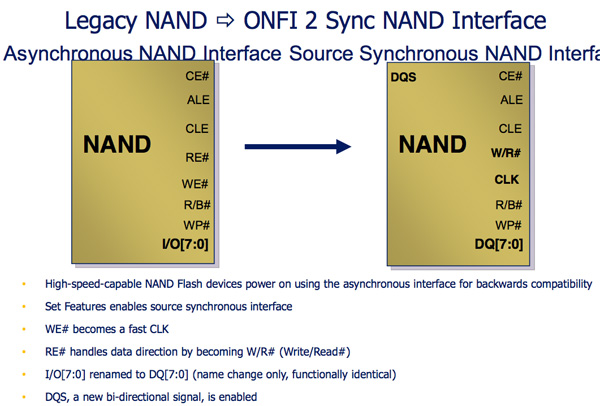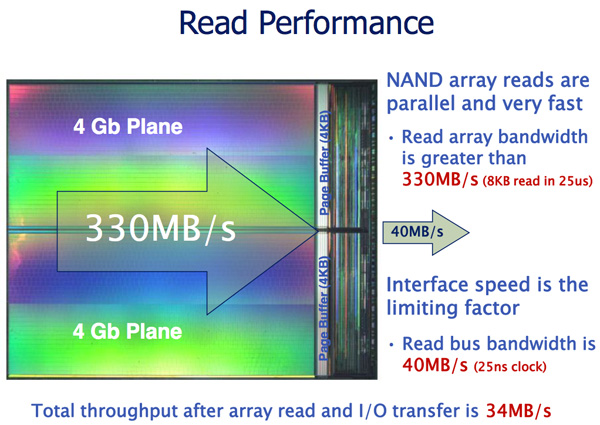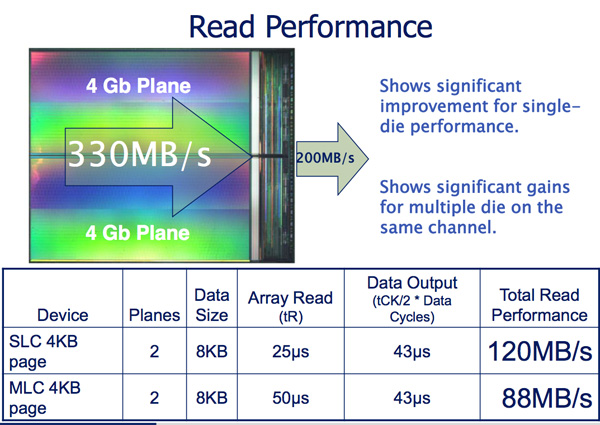SandForce Announces Next-Gen SSDs, SF-2000 Capable of 500MB/s and 60K IOPS
by Anand Lal Shimpi on October 7, 2010 9:30 AM ESTNAND Support: Everything
The SF-2000 controllers are NAND manufacturer agnostic. Both ONFI 2 and toggle interfaces are supported. Let’s talk about what this means.
Legacy NAND is written in a very straight forward manner. A write enable signal is sent to the NAND, once the WE signal is high data can latch to the NAND.
Both ONFI 2 and Toggle NAND add another bit to the NAND interface: the DQS signal. The Write Enable signal is still present but it’s now only used for latching commands and addresses, DQS is used for data transfers. Instead of only transferring data when the DQS signal is high, ONFI2 and Toggle NAND support transferring data on both the rising and falling edges of the DQS signal. This should sound a lot like DDR to you, because it is.

The benefit is tremendous. Whereas the current interface to NAND is limited to 40MB/s per device, ONFI 2 and Toggle increase that to 166MB/s per device.

Micron indicates that a dual plane NAND array can be read from at up to 330MB/s and written to at 33MB/s. By implementing an ONFI 2 and Toggle compliant interface, SandForce immediately gets a huge boost in potential performance. Now it’s just a matter of managing it all.
The controller accommodates the faster NAND interface by supporting more active NAND die concurrently. The SF-2000 controllers can activate twice as many die in parallel compared to the SF-1200/1500. This should result in some pretty hefty performance gains as you’ll soon see. The controller is physically faster and has more internal memory/larger buffers in order to enable the higher expected bandwidths.

Initial designs will be based on 34nm eMLC from Micron and 32nm eMLC from Toshiba. The controller does support 25nm NAND as well, so we’ll see a transition there when the yields are high enough. Note that SandForce, like Intel, will be using enterprise grade MLC instead of SLC for the server market. The demand pretty much requires it and luckily, with a good enough controller and NAND, eMLC looks like it may be able to handle a server workload.










84 Comments
View All Comments
ibudic1 - Thursday, October 7, 2010 - link
Intel will be slower, but I bet it will be more reliable.Intel will also be able to offer twice the storage for the same amount 22nm vs 32 nm.
So high stable performance and twice the area, vs fast and small. So far all of this is vaporware.
Nihility - Thursday, October 7, 2010 - link
I wouldn't call the Intel product vaporware. It's almost guaranteed that they'll ship them on time.ggathagan - Friday, October 8, 2010 - link
I believe ibudic1 was referring to the Sandforce controller as vaporware, not Intel's product.sbrown23 - Thursday, October 7, 2010 - link
You mean 25nm vs 34nm? And Intel products are generally not vaporware. They have a fairly good record of delivery. This isn't Duke Nukem Forever, here.anindividual - Thursday, October 7, 2010 - link
http://www.plianttechnology.com/They have had an enterprise drive line with a proprietary controller on the market for over a year with much of this capability.
bji - Thursday, October 7, 2010 - link
That link indicates that the company in question is using SLC flash in their drives. This is guaranteed to put them out of the same price range as the Intel and Sandforce MLC drives, the latter already being expensive enough to be seriously limited in their market uptake. Conclusion: almost nobody is buying the Pliant Technology drives because they are too expensive compared to other options.mino - Thursday, October 7, 2010 - link
Nobody is willing to go for MLC in REAL enterprise drives.X25-E and the Sandforce stuff is mostly good for HPC and lower mid-range, but mostly DAS setups.
The EMC's of this world use far more robust (and far more pricey) solutions.
nexox - Thursday, October 7, 2010 - link
"""X25-E and the Sandforce stuff is mostly good for HPC and lower mid-range, but mostly DAS setups."""X25-E is an SLC drive. The X25-M is MLC.
"""Nobody is willing to go for MLC in REAL enterprise drives."""
You'll find that vendors are not targeting MLC at enterprises, but rather eMLC, which is somewhat different.
And you'd be wrong about enterprises wanting to avoid eMLC drives. They (will) serve pretty well for many work loads, in places where SLC is cost prohibitive, and spinning disks are too slow.
Casper42 - Friday, October 8, 2010 - link
"Nobody is willing to go for MLC in REAL enterprise drives" ????I work for HP in the Server division and all I can legally tell you is your WRONG.
PS: Ever heard of a slow little drive called the ioDrive Duo? The 640GB model uses MLC. I recently sold 3 of these to a Global 100 company that plans to run a SQL based Data Mining app on them.
HachavBanav - Friday, October 8, 2010 - link
Pliant "LB 150S" = 150GB (2.5" + SLC + SAS dual port ) for $4500 !@anindividual : please ask your boss to review the price, this is just non-sense !